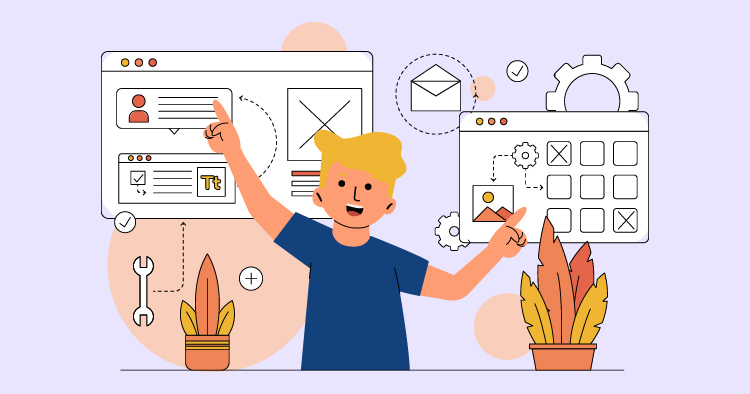WordPress is a robust platform that powers a significant portion of the web. However, as your site grows in content and traffic, you might notice a slowdown in performance. Speed optimization is crucial for maintaining a fast, user-friendly experience that keeps visitors engaged and reduces bounce rates. This article will explore practical strategies for optimizing your WordPress site’s speed, from choosing the right hosting provider to implementing caching solutions and minimizing resource-intensive plugins. By taking these steps, you can ensure your website operates at peak efficiency, providing a seamless experience for your users.
The Need for Speed: Why Website Speed Matters
Why is a fast-loading website so important? Imagine clicking on a website and waiting while the page slowly loads. It’s not just annoying; it can drive people away. For WordPress sites, speed is even more critical. If your site takes too long to load, you could lose visitors and potential customers. They might leave before they’ve even seen what you have to offer.
But it’s not just people who care about speed; search engines do, too. Google, for example, considers how fast a website loads when deciding where it should appear in search results. If you want your WordPress site to be noticed, ensuring it’s quick to load is critical. This will help you rank better and be more visible to those searching online.
Assessing Your Current Website Speed
How do you make your WordPress site faster? First, you need to see how quickly it is right now. Tools like Google PageSpeed Insights are perfect for this. They check out how your site is performing and suggest ways to make it faster. These suggestions could be anything from shrinking image sizes to cleaning up your website’s code.
Once you know your website’s speed, you’ll see what needs to be fixed. Maybe your images are too large, or you have too many plugins slowing things down. By pinpointing these issues, you can make the right changes. This is crucial in making your WordPress site as fast and efficient as possible.
Optimizing Images for Faster Loading
Images are a big part of your website’s content but can slow it down if not properly optimized. Images that are too large take longer to load, which can frustrate visitors and hurt your position in search engine results. The good news is that you can shrink the size of your images without sacrificing quality.
You can use programs like Adobe Photoshop or free online tools to compress your images before uploading them to your site. This means they’ll load faster for your visitors. If you’re using WordPress, you’re lucky because plugins can do this job automatically. One of these plugins will help you optimize all the images on your site for speed.
Choosing the Right Hosting Provider
The company that hosts your website significantly impacts its loading speed. Quick server response times, consistent uptime, and WordPress-friendly support are essential when picking a hosting provider. A reliable host will help your WordPress site run smoothly, with few interruptions and fast page loading times.
Select one of over 500 designs and establish your online presence.
- Free Web Hosting
- Fully Managed Solutions
- Scalable Websites
- No Hidden Cost
When looking for a host for your WordPress site, you’ll find that some companies offer services specifically designed for WordPress. Bluehost and SiteGround, for example, are known for their WordPress hosting plans, which include features that make your WordPress site faster. These providers strike a good balance between performance, helpful customer service, and price, making them solid options for anyone looking to improve their WordPress site’s speed.
Minimizing Plugins and Optimizing Code
Plugins are tools that extend the capabilities of WordPress sites. While they can be instrumental, having too many can lead to slower site performance. It’s essential to review the plugins you have installed regularly and only keep those that are necessary. Doing so reduces the strain on your server, leading to shorter page loading times—a crucial aspect of maintaining a swift and efficient website.
The code that runs your WordPress site can often be streamlined. This means going through your site’s code, including HTML, CSS, and JavaScript, and removing any unnecessary parts. It’s also essential to check that your theme is coded to be as efficient as possible. These steps are not just about tidying up; they directly impact your site’s speed and responsiveness. A clean and optimized codebase allows your website to run more smoothly and quickly, enhancing the user experience.
Caching: Supercharging Your Website Speed
Caching is a powerful way to enhance your website’s performance. It saves a static copy of your pages, which can be quickly served to your visitors without generating the page from scratch each time. This is particularly beneficial for those who visit your site more than once, as they will experience much faster loading times. Caching is a tried-and-tested method of speeding up WordPress and should not be overlooked.
You can use plugins designed for this to implement caching on your WordPress site. Popular options include W3 Total Cache and WP Super Cache. These plugins handle the heavy lifting, automatically creating cached versions of your pages. This means your visitors can access your content more quickly, improving their overall experience on your site. Caching plugins are an invaluable tool for maintaining a high-performance WordPress site.
Content Delivery Networks (CDNs) and Their Role in Speed Optimization
Have you ever wondered why some websites load faster than others, no matter where you are? A big part of the answer lies in a Content Delivery Network, or CDN for short. A CDN is like a web of servers scattered all around the globe, each holding a copy of your website’s content. This setup lets visitors access your site from the server closest to them, which means the information has less distance to travel and loads faster on their screen.
When you use a CDN with your WordPress site, you’re giving it a significant boost in speed and performance. Several CDN services, such as Cloudflare and Akamai, work well with WordPress. They’re not too tricky to set up, and once you do, your website’s content is zipped across the internet in the most efficient way possible. This is a big win for anyone looking to make their WordPress site faster.
Database Optimization for Improved Performance
As your WordPress site grows, so does its database, and just like a closet, it can get filled with things you don’t need anymore. This clutter can slow your website down. That’s why it’s essential to keep your database tidy and well-organized. Think of it as regular spring cleaning for your website. You’ll want to clear outdated data, ensure your tables are in good shape, and keep everything running smoothly.
Luckily, you don’t have to be a tech wizard to keep your database in tip-top condition. Tools and plugins, like WP-Optimize, make this job easy. They let you clean up and optimize your database with just a few clicks. Using these tools regularly is like giving your website a health check-up, ensuring it stays quick and responsive for your visitors. This is a critical step in ensuring your WordPress site performs at its best.
Select one of over 500 designs and establish your online presence.
- Free Web Hosting
- Fully Managed Solutions
- Scalable Websites
- No Hidden Cost
Minifying CSS and JavaScript Files
Minification is a technique for reducing the size of your CSS and JavaScript files. It involves stripping out all the unnecessary characters—like spaces, line breaks, and comments—that don’t contribute to the code’s functionality. By doing this, the files become smaller, which means browsers can download them more quickly. This is a crucial step in making your WordPress site load faster.
Several tools and plugins are at your disposal to simplify minification. For instance, Autoptimize and WP Rocket are popular choices that handle this task automatically. When you use these plugins, they take care of all the technical details, ensuring your website’s code is lean and efficient. This is essential to keeping your WordPress site running smoothly and quickly.
Implementing Lazy Loading for Images and Videos
Lazy loading is an intelligent way to improve your website’s loading time. Instead of loading all images and videos as soon as someone visits a page, lazy loading waits until those visuals are in view. So, as a user scrolls down the page, content loads just in time for them to see it. The page’s initial load is much lighter and quicker because heavy media files do not bog it down.
Adding lazy loading to your WordPress site is straightforward. Many modern themes include this feature by default. If your theme doesn’t or wants more control, you can use plugins like WP Rocket or Jetpack. These plugins are designed to make lazy loading easy to implement. With a few clicks, you can activate this feature, which will start working automatically, making your website faster and more efficient for visitors.
Utilizing Content Delivery Networks (CDNs) for Media Files
Content Delivery Networks, or CDNs, are crucial for improving the speed and performance of a WordPress site. When you use a CDN, your media files, such as images and videos, are stored on multiple servers worldwide. This means that when someone visits your website, they receive content from the server closest to them. As a result, your website loads faster, which is particularly beneficial for visitors from around the globe.
Setting up a CDN with your WordPress site is straightforward. Several CDN providers exist, including popular options like Cloudflare and Akamai. These services provide simple instructions to connect your WordPress media library to their network. Once you’ve set it up, your media content is more efficiently served to your visitors, speeding up your site’s overall experience.
Enabling Gzip Compression for Reduced File Sizes
Gzip compression is a technique that minimizes the size of the files that your website sends to visitors’ browsers. Smaller files mean that your website can load more quickly, which improves the user experience and can also help with your site’s search engine rankings.
Gzip compression compresses HTML, CSS, and JavaScript files to make your website files smaller before sending them online. This makes your website lighter and your pages load faster.
You can turn on Gzip compression in WordPress in a couple of ways. One method is to edit the .htaccess file on your server. However, if you’re uncomfortable editing system files, you can use a plugin. Many plugins, like WP Fastest Cache, are designed to improve website speed, and they can handle the Gzip compression for you. Using such a plugin, you can easily activate Gzip compression and enjoy a faster-loading website without needing to delve into the technical details.
Optimizing WordPress Themes and Templates
Choosing a suitable theme for your WordPress website is essential for its performance. It’s best to select themes that are designed to be fast and efficient. A heavy theme with unnecessary features can slow down your website, which you want to avoid.
After picking a theme, the next step is to tailor it for the best performance. This means you should use widgets sparingly, especially resource-intensive ones. Also, ensure your images are optimized for the web—they should be the right size and file format to load quickly without losing quality. Additionally, check that the theme’s code is clean and well-written, which can significantly affect how fast your site runs.
Monitoring and Regular Maintenance for Sustainable Performance
To keep your WordPress site running smoothly, you must monitor and regularly maintain its performance. This includes updating your site, creating backups, and checking how quickly your pages load.
Tools like Google Analytics and PageSpeed Insights are handy for monitoring your site’s performance. To get the best speed and security, ensure you’re always running the latest version of WordPress and your themes and plugins. By staying on top of these tasks, you can help ensure your WordPress site continues to perform well over time.
Testing and Benchmarking Your Optimized Website
Testing and seeing their effect is essential once you’ve implemented optimizations on your website. Several tools are available to help you with this. GTmetrix and Pingdom provide detailed insights into how well your site is performing. They can show you how fast your pages load and pinpoint what works well and what might still need improvement.
Benchmarking is another crucial step. By comparing your site’s performance before and after you’ve made changes, you can see exactly how much of an impact your efforts have had. It’s good practice to keep track of these benchmarks over time. This helps you see your progress and guides you in deciding what to focus on next to keep improving your site’s speed.
Common Mistakes to Avoid in WordPress Speed Optimization
When working to speed up a WordPress site, there are a few pitfalls you’ll want to avoid. One of the most common mistakes is adding too many plugins. While plugins can add valuable features to your site, having too many can slow it down. It’s also common to see websites using images that haven’t been optimized for the web, which can significantly slow down page load times.
Another mistake to avoid is choosing a hosting service that doesn’t meet your needs. Not all hosting services are created equal, and some might not offer the performance you need for a fast-loading site.
To prevent these issues, back up your site regularly. This protects your data in case something goes wrong. Be selective with the plugins you use—only install what you genuinely need, and test them to see how they affect your site’s performance. Please focus on the optimizations that have the most significant impact on speed. Don’t forget to review and audit your site regularly to maintain its performance and avoid common speed optimization errors.
Final Thoughts
Optimizing your WordPress site for speed is not just about enhancing user experience; it’s also about improving your site’s search engine rankings. A faster site can lead to better engagement, increased conversions, and a more robust online presence. Remember, the journey to a quicker website involves regular maintenance, monitoring, and updates. Applying the tips in this article, you can take significant strides towards a more responsive and successful WordPress website. Stay committed to performance optimization; your efforts will undoubtedly pay off in the long run.



